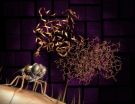(Press-News.org) An international team of scientists, using the world's most powerful X-ray laser, has revealed the three dimensional structure of a key enzyme that enables the single-celled parasite that causes African trypanosomiasis (or sleeping sickness) in humans.
With the elucidation of the 3D structure of the cathepsin B enzyme, it will be possible to design new drugs to inhibit the parasite (Trypanosoma brucei) that causes sleeping sickness, leaving the infected human unharmed.
The research team, including several ASU scientists, is led by the German Electron Synchrotron (DESY) scientist Henry Chapman from the Center of Free-Electron Laser Science (CFEL), professor Christian Betzel from the University of Hamburg and Lars Redecke from the SIAS joint Junior Research Group at the Universities of Hamburg and Lübeck. They report their findings this week in Science.
"This is the first new biological structure solved with a free-electron laser," said Chapman of the development.
"These images of an enzyme, which is a drug target for sleeping sickness, are the first results from our new 'diffract-then-destroy' snapshot X-ray laser method to show new biological structures which have not been seen before," explained John Spence, ASU Regents' Professor of Physics. "The work was led by the DESY group and used the Linac Coherent Light Source at the U.S. Department of Energy's SLAC National Accelerator Laboratory."
Transferred to its mammalian host by the bite of the tsetse fly, the effects of the parasite are almost always fatal if treatment is not received. The sleeping sickness parasite threatens more than 60 million people in sub-Saharan Africa and annually kills an estimated 30,000 people. Current drug treatments are not well tolerated, cause serious side effects and the parasites are becoming increasingly drug resistant.
"This paper is so exciting as it is based on nanocrystals grown by the groups at DESY in Hamburg and at the University of Lübeck inside living insect cells," said Petra Fromme, a professor in ASU's Department of Chemistry and Biochemistry. "This is the first novel structure determined by the new method of femtosecond crystallography. The structure may be of great importance for the development of new drugs to fight sleeping sickness, as it shows novel features of the structure of the CatB protein, a protease that is essential for the pathogenesis, including the structure of natural inhibitor peptide bound in the catalytic cleft of the enzyme."
An additional difficulty includes the fact that the cathepsin B enzyme is also found in humans and all mammals. However the discovery of the enzyme's 3D structure has enabled the researchers to pinpoint distinctive structural differences between the human and the parasite's form of the enzyme. Subsequent drug targets can selectively block the parasite's enzyme, leaving the patient's intact.
INFORMATION:
In addition to Spence and Fromme, other ASU members of the team are Bruce Doak, professor of physics; Uwe Weierstall, research professor in physics; faculty research associates Raimund Fromme, Ingo Grotjohann and Tzu-Chiao Chao; Nadia Zatsepin, post-doctoral researcher, graduate students Christopher Kupitz (Biochemistry), D. Wang (Physics) and Mark Hunter and Richard Kirian who graduated with Ph.D.s from ASU in Chemistry and Physics respectively and now work on the femtosecond crystallography project at Lawrence Livermore National Laboratory and DESY.
The ASU group developed the sample delivery system, worked on the characterization of the crystals with dynamic light scattering and SONNIC and did the early development work on the new data analysis method. All ASU participants are members of the College of Liberal Arts & Sciences.
International team members in addition to those already mentioned include researchers from the Max Planck Institute, Heidelberg, University of Gothenburg, University of Tübingen and Lawrence Livermore National Laboratory.
Jenny Green, jenny.green@asu.edu
480-965-1430
X-ray laser helps slay parasite that causes sleeping sickness
2012-12-06
ELSE PRESS RELEASES FROM THIS DATE:
Researchers identify proteins that indicate which kidney tumors are most likely to spread
2012-12-06
TORONTO, Dec. 5, 2012—Researchers at St. Michael's hospital have identified 29 proteins that are likely to be involved in the spread of kidney cancer. The discovery will help physicians recognize which tumours are going to behave more aggressively and provide those patients with more intensive treatment and closer followup.
"Metastatic renal cell carcinoma is one of the most treatment-resistant malignancies and patients have dismal prognosis," said Dr. George M Yousef, a laboratory pathologist. "Identification of markers that can predict the potential of metastases will ...
Clinical trial tests rice bran to prevent cancer
2012-12-06
A recent University of Colorado Cancer Center review in the journal Advances in Nutrition shows that rice bran offers promising cancer prevention properties. Meanwhile, an ongoing clinical trial is testing the effectiveness of rice bran in preventing the recurrence of colon cancer.
"While I have been trained as a molecular toxicologist, I am excited about the opportunities to deliver bioactive, cancer fighting compounds with food, and this has led to my focus now primarily on the multiple drug-like characteristics of rice bran," says Elizabeth P. Ryan, PhD, CU Cancer ...
Adolescents under pressure to speak 'properly'
2012-12-06
EAST LANSING, Mich. — As adolescents transition to adulthood, the pressure to meet adult expectations – such as speaking properly – may be greater than expected, according to a new study by a Michigan State University researcher.
Suzanne Evans Wagner, assistant professor of linguistics, has proven for the first time that language changes with age in addition to community pressures. And, surprisingly, college and post-high school ambitions play a huge role.
"It seems as if in high school, students who want to go to a good college are the ones who early on begin to dial ...
Exercise affects reproductive ability in horses
2012-12-06
In the latest issue of the Journal of Animal Science, researchers at Clemson University and the University of Florida examine the impact of exercise on mare reproductive health and embryo transfer.
In the study, researchers divided light-horse mares into three research groups: no exercise (control), partial-exercise and full-exercise. Their goal was to measure reproductive blood flow and embryo number and quality. Partial-exercise mares were moderately exercised for 30 minutes daily during the periovulatory period and rested after ovulation for seven days. Full-exercise ...
NASA-NOAA satellite reveals new views of earth at night
2012-12-06
VIDEO:
This new global view and animation of Earth’s city lights is a composite assembled from data acquired by the Suomi NPP satellite. The data was acquired over nine days in...
Click here for more information.
Scientists unveiled today an unprecedented new look at
our planet at night. A global composite image, constructed using
cloud-free night images from a new NASA and National Oceanic and
Atmospheric Administration (NOAA) satellite, shows the glow of
natural and ...
New report finds increase in media coverage of synthetic biology
2012-12-06
WASHINGTON – Press coverage of synthetic biology in the United States and Europe increased significantly between 2008 and 2011, according to a report released today by the Synthetic Biology Project at the Woodrow Wilson International Center for Scholars.
The report, Trends in American and European Press Coverage of Synthetic Biology: 2008 – 2011, builds on the project's earlier study of US-EU press coverage between 2003 and 2008. Synthetic biology, an area of research focused on the design and construction of new biological parts and devices, or re-design of existing ...
Synthetic fuel could eliminate US need for crude oil
2012-12-06
The United States could eliminate the need for crude oil by using a combination of coal, natural gas and non-food crops to make synthetic fuel, a team of Princeton researchers has found.
Besides economic and national security benefits, the plan has potential environmental advantages. Because plants absorb carbon dioxide to grow, the United States could cut vehicle greenhouse emissions by as much as 50 percent in the next several decades using non-food crops to create liquid fuels, the researchers said.
Synthetic fuels would be an easy fit for the transportation system ...
New '4-D' transistor is preview of future computers
2012-12-06
WEST LAFAYETTE, Ind. – A new type of transistor shaped like a Christmas tree has arrived just in time for the holidays, but the prototype won't be nestled under the tree along with the other gifts.
"It's a preview of things to come in the semiconductor industry," said Peide "Peter" Ye, a professor of electrical and computer engineering at Purdue University.
Researchers from Purdue and Harvard universities created the transistor, which is made from a material that could replace silicon within a decade. Each transistor contains three tiny nanowires made not of silicon, ...
NASA satellites analyze Typhoon Bopha inside and out
2012-12-06
Typhoon Bopha proved deadly to residents in the Mindanao region of the Philippines after ravaging islands in Micronesia. NASA's Aqua and TRMM satellites peered at the storm inside and out, providing forecasters with valuable data as the storm moved into the South China Sea.
On Dec. 5, 2012, Bopha crossed over Palawan and entered the South China Sea after crossing over the southern Philippines' Mindanao region, leaving death and destruction in its wake. According to Reuters news reports on Dec. 5, at least at total of 283 people were killed and hundreds remain missing ...
Plant stress paints early picture of drought
2012-12-06
In July 2012, farmers in the U.S. Midwest and Plains regions watched crops wilt and die after a stretch of unusually low precipitation and high temperatures. Before a lack of rain and record-breaking heat signaled a problem, however, scientists observed another indication of drought in data from NASA and NOAA satellites: plant stress.
Healthy vegetation requires a certain amount of water from the soil every day to stay alive, and when soil moisture falls below adequate levels, plants become stressed. Scientists with the U.S. Department of Agriculture's Agricultural Research ...




